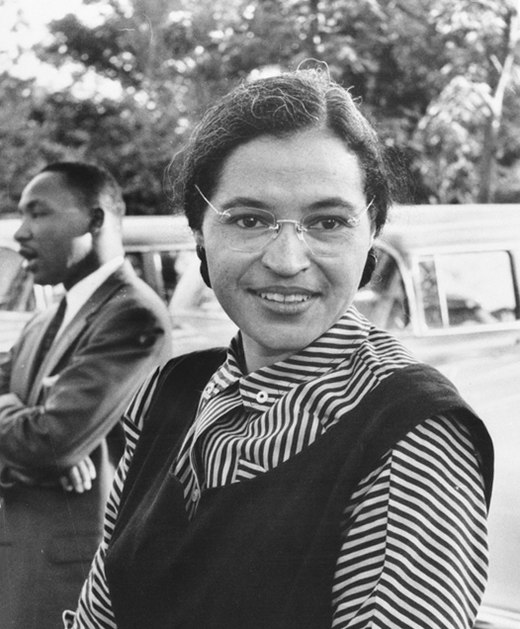Important dates
- February 4, 1913: birth of Rosa Louise McCauley
- 1932: get married
- 1933: obtain hgh school degree
- December 1, 1955: refuse to give up her seat
- December 5, 1955: Montgomery African-American community starts boycotting the city bus company
- December 20, 1956: after a 381 days boycott, legal action are taken
- October 24, 2005: Rosa Parks died in Detroit at 92 years old.
You must never be fearfull about what you are doing when it is right
Parks was born to Rosa Louise McCauley on February 4, 1913 in Tuskegee, Alabama. Her parents, James and Leona McCauley, split up when Parks was two years old. The parks moved to Pine Level with their mother, Alabama to live with her parents, Rose and Sylvester Edwards. Both Park’s grandparents were former slaves and strong advocates of racial equality; the family lived on Edwards’ farm, where Parks spent her youth. Parks’ childhood brought her early experiences of racial discrimination and activism for racial equality.
Rosa attended segregated schools and went to an isolated single-room school in Pine Level, Alabama, where there was often a shortage of desks and other sufficient school supplies. African-American students were forced to walk to the first- to sixth-grade school buildings, while the Pine-level cities provided white students with bus transportation and a new teaching building. From the age of 11, Parks attended the Montgomery City Girls’ Industrial School. She left the school and took care of her sick grandmother and mother. Rosa did not return to her studies. Instead, she found a job at a shirt factory in Montgomery. After getting married in 1932, she obtained a high school degree in 1933 with the support of her husband.
On December 1, 1955, after a full day of tailoring at the Montgomery Department Store, Parkes boarded a bus on Cleveland Avenue to go home. She sat down in the first row of the rows of seats designated for “colored” passengers. The Montgomery City regulations require that all public transportation be segregated, and the bus driver should have the “city police power and be actually responsible for any bus to enforce the regulations”. When operating buses, drivers are required to provide separate but equal accommodation for white and black passengers by allocating seats. As the Parks bus continued to travel along the way, it began to fill with white passengers. Eventually, the bus was full and the driver noticed that several white passengers were standing in the aisle. The bus driver stopped the bus, moved the sign separating the two parts backward by one line, and asked four black passengers to abandon their seats. The city’s public transport regulations do not explicitly give drivers the power to require passengers to give up anyone’s seat, regardless of color. However, the bus driver in Montgomery has become accustomed to moving the sign separating black and white passengers backward, and requires black passengers to hand over their seats to white passengers when necessary. If black passengers protest, the bus driver has the right to refuse service and can call the police to dismiss them.
The other three black passengers on the bus were in compliance with the driver, but Parks refused and kept her seat. The driver asked, “Why don’t you stand up?” Parks replied, “I shouldn’t stand up.” The driver called the police and arrested her. On Monday, December 5, 1955, on the day of Parks’ trial, members of the African American community were asked to leave work to protest her arrest. Encourage people to go to get off work or school, take a taxi or walk to work. With most African-American communities not using buses, organizers believe that a longer boycott may succeed. As we all know, the boycott of the Montgomery bus was a huge success. It lasted 381 days and finally declared the isolation of the public transportation system unconstitutional in a Supreme Court ruling. Undoubtedly, the biggest event of the day was what triggered the Parks trial. Buses in the city are mostly empty. Some people carpooled, others took taxis driven by African Americans, but most of the approximately 40,000 African American commuters who lived in the city at that time chose to walk to work-some up to 20 miles long.
Due to the scale, scope and loyalty of the boycott, this effort lasted for several months. Montgomery has become the eyes of victory, and dozens of public buses are idle, which ultimately seriously damages the financial situation of the bus company. Some segregationists retaliate with violence. Multiple black church was burned down and the houses of King and E.D. Nixon were blown up. However, people tried further to end the boycott. The urban taxi system used by African Americans cancels insurance. Black citizens were arrested for violating outdated laws prohibiting boycotts.
Due to the economic losses suffered by the bus companies and downtown businesses, and the legal system ruling them, Montgomery had no choice but to abolish the segregation of public buses. The boycott operation officially ended on December 20, 1956. Supported by the unwavering determination of the African American community, legal action has made the Montgomery Bus Boycott Movement one of the largest and most successful mass movements against apartheid in history. On October 24, 2005, Parks quietly died in her apartment in Detroit, Michigan, at the age of 92.
Parks’ death was marked by several memorial services, including the Capitol Rotunda in Washington DC, which was estimated to have seen 50,000 people watch her coffin. She was detained by her husband and mother at the Woodlawn Cemetery in Detroit, the church tomb. Shortly after her death, the church was renamed Rosa L. Parks Liberty Church.

